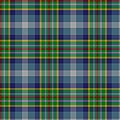
Queensland is a state in north-eastern Australia, the second-largest and third-most populous of the Australian states. It is bordered by the Northern Territory, South Australia and New South Wales to the west, south-west and south respectively. To the east, Queensland is bordered by the Coral Sea and the Pacific Ocean; to its north is the Torres Strait, separating the Australian mainland from Papua New Guinea, and the Gulf of Carpentaria to the north-west. With an area of 1,729,742 square kilometres (667,857 sq mi), Queensland is the world's sixth-largest sub-national entity; it is larger than all but 16 countries. Due to its size, Queensland's geographical features and climates are diverse, including tropical rainforests, rivers, coral reefs, mountain ranges and sandy beaches in its tropical and sub-tropical coastal regions, as well as deserts and savanna in the semi-arid and desert climatic regions of its interior.

The current state flag of the Northern Territory, Australia was officially adopted in 1978. The Northern Territory has been in existence since 1911, but did not hoist its first flag until self-government in 1978.

The coat of arms of Australia, officially the Commonwealth Coat of Arms, is a formal symbol of the Commonwealth of Australia. It depicts a shield, containing symbols of Australia's six states, and is held up by native Australian animals, the kangaroo and the emu. The seven-pointed Commonwealth Star surmounting the crest also represents the states and territories, while golden wattle, the national floral emblem, appears below the shield.

Regional tartans of Canada are represented by all Canada's provinces and territories having a regional tartan, as do many other regional divisions in Canada. Tartans were first brought to Canada by Scottish settlers; the first province to adopt one officially was Nova Scotia in 1956, and the most recent province was Ontario, in 2000. Except for the tartan of Quebec, all of the provincial and territorial tartans are officially recognized and registered in the books of the Court of the Lord Lyon, King of Arms of Scotland.

The coat of arms of Victoria is the official heraldic symbol of the Australian state of Victoria. Victoria was the second state of Australia to gain arms, granted on 6 June 1910 by royal warrant of King George V. The state had been named in 1851 after his grandmother, who reigned at the time. The current version of the arms was granted 28 March 1978 in the royal warrant issued by Queen Elizabeth II.

The state flag of Queensland is a British Blue Ensign with the state badge on a white disc added in the fly. The badge is a light blue Maltese Cross with a Saint Edward's Crown in the centre of the cross. The flag dates from 1876, with minor variations, and the badge was designed by William Hemmant, the Colonial Secretary and Treasurer of Queensland in 1876.

The coat of arms of Queensland is one of the formal symbols of the State of Queensland and represents the King's constitutional authority throughout the state. It is the oldest of the state arms of Australia, having been granted in 1893 by Queen Victoria, through the simplest heraldic grants of only the shield of arms, motto, helmet, mantling and crest. In 1977, the red deer and the brolga were assigned as supporters by Queen Elizabeth II during her Silver Jubilee.

The Normanby River, comprising the East Normanby River, the West Normanby River, the East Normanby River North Branch, the East Normanby River South Branch and the Granite Normanby River, is a river system in Far North Queensland, Australia.
Ontario is a province of Canada that has established several official emblems and symbols to reflect the province's history, natural resources, and its people. In addition to official symbols, several other emblems and symbols exist that are commonly associated with the province.
National symbols of Australia are the official symbols used to represent Australia as a nation or the Commonwealth Government. Additionally, each state and territory has its own set of symbols.

Dendrobium bigibbum, commonly known as the Cooktown orchid or mauve butterfly orchid, is an epiphytic or lithophytic orchid in the family Orchidaceae. It has cylindrical pseudobulbs, each with between three and five green or purplish leaves and arching flowering stems with up to twenty, usually lilac-purple flowers. It occurs in tropical North Queensland, Australia and New Guinea.

The historical flags of the British Empire and the overseas territories refers to the various flags that were used across the various Dominions, Crown colonies, protectorates, and territories which made up the British Empire and overseas territories. Early flags that were used across the Empire tended to be variations of the Red and Blue Ensigns of Great Britain with no colonial badges or coat of arms attached to them. In the first half of the 19th century, the first colonies started to acquire their own colony badges, but it was not until the UK Parliament passed the Colonial Naval Defence Act 1865 that the colonies were required to apply their own emblems.

The Peninsula Developmental Road (PDR) runs 571 km (355 mi) from Lakeland to Weipa. It is the main road transport link within Cape York Peninsula and to the rest of the Australian mainland.

Australian heraldry is the term for the style of armorial achievements, sometimes known as coats of arms, and other heraldic bearings and insignia used in Australia. It largely follows the Gallo-British tradition of heraldry also followed in England, Scotland, Ireland, Canada and New Zealand.

District tartans for the Commonwealth of Australia and for each of its constituent States have been registered in the Scottish Register of Tartans (SRT). Additionally, fashion tartans covering either Australia as a whole, or its capital city, Canberra, have been registered in the SRT, as have district tartans in respect of some of Australia's local government areas.



















